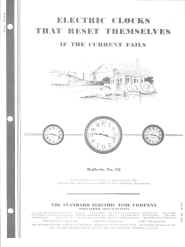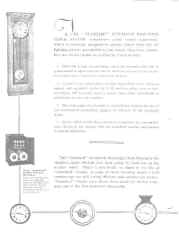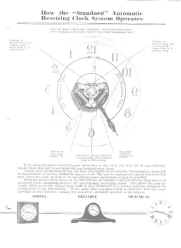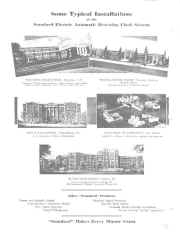



Original Standard Electric Time Co. publication
circa 1932
Reprinted 1994 under the auspices of Jeffrey R. Wood, Wilbraham, Massachusetts
provided to this site by Tim Akins
To view or download scans of the original
document:




THE STANDARD ELECTRIC TIME COMPANY
Springfield, Massachusetts
| ATLANTA, 903 Williams Mill Road, N.E. | BOSTON, 10 High Street | Columbus, 83 South High St. | KANSAS CITY, Mutual Bldg. |
| BALTIMORE, Central Savings Bank Bldg. | BUFFALO, 220 Delaware Ave. | DALLAS, 5252 Vanderbilt St. | MINNEAPOLIS, Pence Bldg. |
| BIRMINGHAM, 2920-7th Ave., So. | CHICAGO, Monadnock Bldg. | DENVER, 562 Pennsylvania St. | NEW YORK CITY, 50 Church St. |
| PHILADELPHIA, Architects Bldg. | SCRANTON, 148 Adams Ave. | TAMPA, 5505 Central Ave. |
| THE STANDARD ELECTRIC TIME CO. OF CALIFORNIA, 268 Market St., SAN FRANCISCO, CALIF. LOS ANGELES, Hollingsworth Bldg. |
| THE STANDARD ELECTRIC TIME CO. OF CAN., LTD., 726 St. Felix St., MONTREAL, P.Q., CAN |
THE "STANDARD" AUTOMATIC RESETTING CLOCK SYSTEM (sometimes called hourly supervised), which is normally designed to operate direct from the AC lighting service, accomplishes four major objectives, heretofore not all obtainable in an Electric Clock System.
The "Standard" Automatic Resetting Clock System is the simplest, most effective and least costly to maintain on the market today. There is practically no limit to the life of "Standard" Clocks, as some of them installed nearly a half century ago are still giving efficient and satisfactory service. "Standard" Clocks have always been made by skilled workmen and of the best materials obtainable.
New "Standard" Stable Voltage Rectifier: This system operates from the lighting curent through a dry plate stable voltage rectifier with the secondary clocks on a 3 wire circuit.
If the clocks by chance should become either fast or slow or in any way out of step with the master clock they will be automatically synchronized every hour.
Assume that the lighting current has been interrupted for 25 minutes, the secondary clocks will be that number of minutes behind the master clock. The master continues to run for it is furnished with either one-hour, six-hour or six-day driving power mechanism as may be specified.
When the master clock arrives at the 59th minute, an impulse is sent out over the third wire to all secondary clocks energizing magnet "B" and releasing the locking pawls. This allows the counterweight which is on the minute hand staff to drop downward to a vertical position, bringing the minute hand to the 59th minute. At the same time a magnetic field is created to hold the counterweight in this position, making the correction absolutely accurate to the minute.
schools pictured:
MALVERNE HIGH SCHOOL, Malverne, N.Y. - Frederick P. Wiedersum, Architect, Valley Stream, Long Island; Kopf & Sears, Engineers, 13 E. 37th St., New York City
THOMAS EDISON SCHOOL (Bennett District), Boston, Mass. - Allbright & Blaney, Architects, Boston
GIRLS' HIGH SCHOOL, Philadelphia, Pa., I.T. Catherine, Architect, Philadelphia
UNIVERSITY OF CALIFORNIA, Los Angeles, George W. Kelham, Architect, Los Angeles, San Francisco
SENIOR HIGH SCHOOL, Quincy, Ill., John D. Chubb, Architect, Chicago, Ill.; Behrensmeyer & Hafner, Associates, Quincy, Ill.
Tower and Outside Clocks Hospital Signal Systems
Experimental Laboratory Panels Electric Stop Clocks
Fire Alarm Systems Demand Meter Control Equipment
School Telephones Meter Testing Timing Equipment
Return to SETCLOCKS - A Tribute to The Standard Electric Time Company